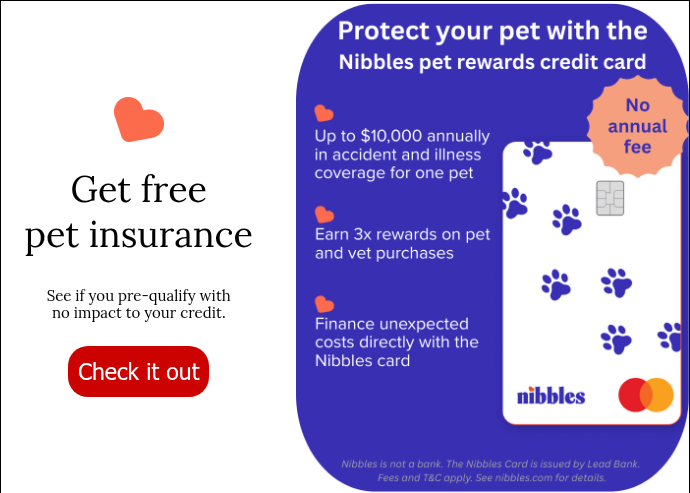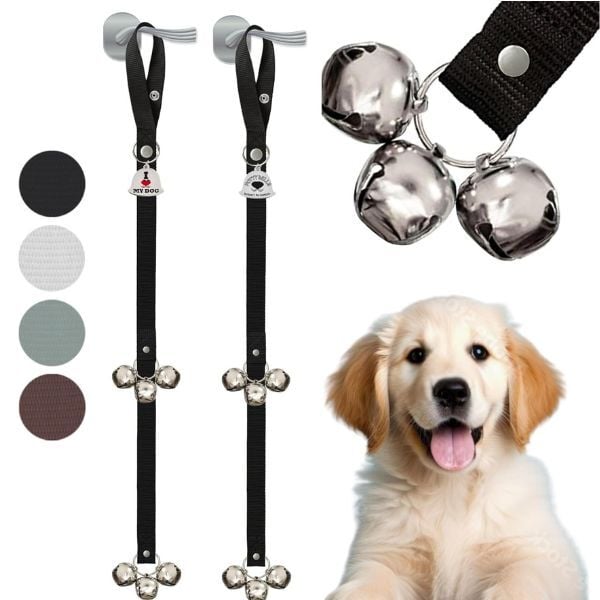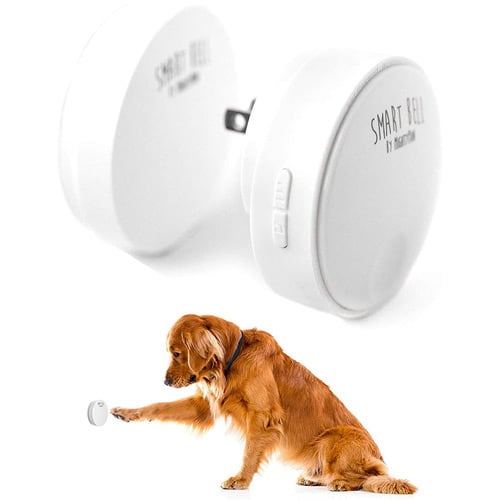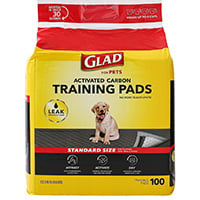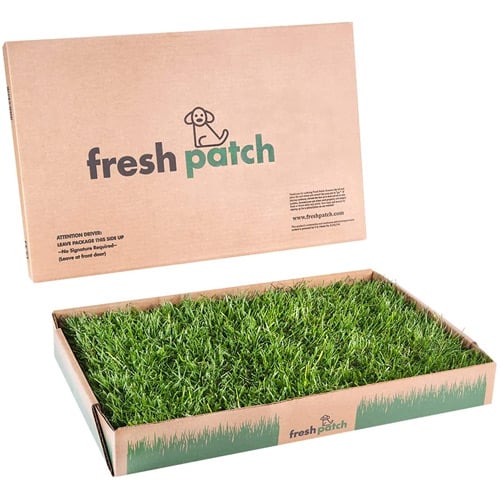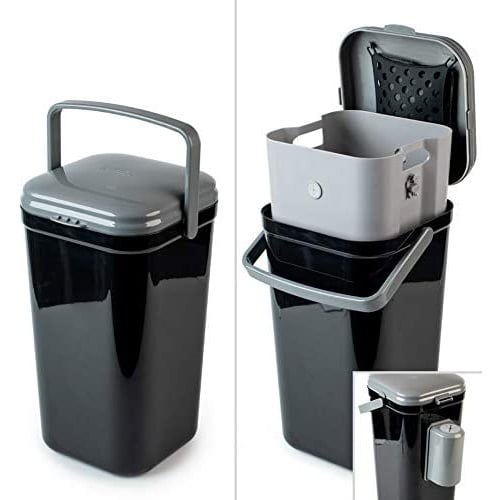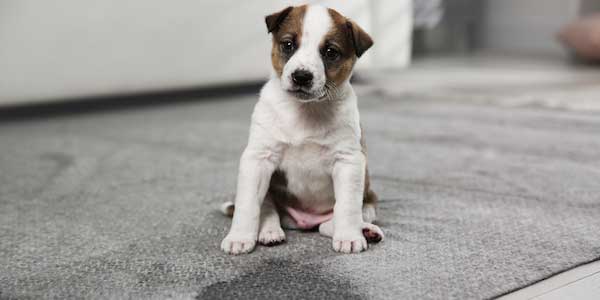
When you bring home a new puppy, you'll want to get started on house training as soon as possible.
Potty training a puppy might feel daunting at first, but the steps are actually quite simple. It's staying consistent that's the tough part, especially if you have multiple members of your family helping you raise a puppy.
We've got ideas to help you set up a potty training schedule and tips to help your puppy stay on track with house training.
And if you've recently brought home an adult dog that's having potty training issues, check out our article "How to Potty Train an Adult Dog" for more age-specific tips!
Table of Contents
- Puppy Potty Training Steps
- How Long Can Your Puppy "Hold It?"
- Potty Training a Puppy at Night
- Signs Your Puppy Needs to Go Potty
- Training Your Puppy to Use Potty Bells
- Should You Use Puppy Pee Pads?
- What to Do (and NOT Do) When Your Puppy Has a Potty Accident
- Medical Issues that Inhibit Puppy Potty Training
- Puppy Potty Training Regression
How Long Does Potty Training a Puppy Take?
The answer to this question depends mostly on you! If you are consistent with your puppy's house training, it might only take a week or two for your puppy to be reliably potty trained.
While they might get the hang of it quickly, that doesn't mean you're off the hook! And many puppies have times of regression in potty training, even when you're doing everything right.
The overall potty training process tends to last about four to six months as your puppy physically matures into adolescence.
Until your puppy is at least six to eight months old, you'll need to follow a frequent potty break schedule and consistently reward them for going to the bathroom outside.
Even with great house training on your part, there will still be potty accidents. Common reasons your puppy might be having potty accidents include:
Timing and Frequency. Depending on how old your puppy is, they might need more frequent breaks outside than you might expect. Read further below about how often you should plan to take your puppy outside (and what you can do if you live in an apartment or other home setup that makes frequent trips outside a but more difficult).
Stomach upset. Sometimes a too-varied diet can cause stomach aches, such as lots of different treats or changing food too quickly. Having stomach pain makes it harder to hold it until the next potty break.Medical issue. Even if you're keeping a regular feeding and break schedule, if your puppy is still having accidents, it could be a medical issue. Click here to skip to medical issues that could be causing regression in your puppy's potty training.
Breed or Breed Mix. In my experience, toy breeds sometimes take longer to house train than larger breeds — their little bladders are just so tiny! We often don't realize how often they need to go out. They also might be less inclined to go outside in inclement weather like rain or snow compared to larger dogs.
Transition away from potty pads. I've also seen house training take longer when transitioning from using potty pads indoors to an outside-only routine, as your puppy is learning a new habit and might be expected to hold it longer than they are able to. Are you thinking about using pee pads for potty training? There are pros and cons — read more in "Pee Pad Training: Is It a Good Idea?"
Remember, your puppy is unique, and their potty training success depends on you. While some puppies might take longer to grasp the concept of only going to the bathroom outside, the more committed you are to the steps outlined below, the faster you'll see results!
How to House Train a Puppy
Choose a Regular Outside Potty Area
Pick a spot where you'd like your puppy to go to the bathroom regularly. This can be a particular corner of your yard or patio area, or a certain section of a sidewalk with grass to the side.
Often puppies will find gravel or rocks uncomfortable to walk on (or want to eat the gravel!), so I recommend looking for softer surfaces for their potty area.
For puppies that haven't completed their entire puppy vaccine series, it's best to avoid areas that other dogs use as a potty spot to help prevent any disease or illness transmission.
Bringing your puppy to the same spot all the time is super helpful and should speed things up. They pick up on the smells from where they went before, so it gives them the cue to go.
PRO TIP: Keeping your potty trip supplies (leash, collar or harness, training treats, poop bags, and flashlight) hung conveniently by the door will save you time when you need to get your puppy out quickly!
This is especially useful when you're half-asleep and taking your pup out for nighttime potty break. Make sure your supplies are hung up high and secure so your puppy doesn't try to raid the bag of treats when you're not looking.
You might be using puppy potty pads or disposable "grass" patches, especially if you live in an apartment or other type of home that doesn't have easy outdoor access.
For these situations, I recommend choosing a spot located on an outdoor patio (if you have one your dog can't escape from, or jump over or slip through the railing), or an area that's far away from your puppy's sleeping or play areas. (If you're utilizing a puppy zone playpen area, the pee pad area should be as far away from their resting area as possible within the pen.)
Choose a place that's easy to clean in case your puppy misses their pad by an inch or two — tile floors are much easier to thoroughly clean than carpet! Placing pee pads near the door that leads outside can help with future transitioning to outdoor-only bathroom routines.
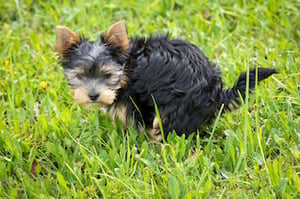
Puppy Potty Training Steps
Step One: Take your puppy on a leash to their potty spot. Stand quietly and let your puppy sniff in that area.
Step Two: Praise and reward them if they go potty! Make sure to wait until they've finished their business before giving excited praise or offering a treat — you don't want to distract them before they're fully done.
Step Three: If they don't go potty after one to two minutes of being in their spot, return inside. Don't let them play outside or do anything else other than their potty business. Play and rewards only come after they're done, not before.
You'll want to try again after waiting a short time. Don't allow them the freedom to roam during this period. Instead, keep them tethered to you (with an "umbilical cord" leash) so you can watch for indications they need to go potty (such as sniffing the ground, pacing, or turning in circles).
If you're unable to keep a close eye on them, place them in their crate or puppy pen. Wait just five to ten minutes before taking them outside again for another chance to go potty.
If they DO have a successful potty break, you can allow them some supervised freedom inside your home. Don't let them wander around for too long. Refer to the puppy house training flow chart further below to determine when their next potty break should be.
Add a "Go Potty" Cue
If you'd like to be able to ask your puppy to go potty on cue, it's easy to teach! It's all about creating an association of the words with the action of going to the bathroom, which just takes repetition. To learn how, check out "4 Easy Steps to Teach Your Puppy to Go Potty on Cue."
Take Your Puppy to Their Potty Spot FREQUENTLY
Your puppy doesn't automatically know where they should and shouldn't relieve themselves. Fortunately, dogs generally do not like to go to the bathroom where they sleep or rest, making crate training a useful house training tool.
To teach them that going to the bathroom outside is rewarding for them, they first have to go potty outside so you can then reward it!
How do you do this? You give them lots of opportunities to be successful and take them to their potty spot ALL. THE. TIME.
Then you can "capture" the behavior when it happens and give them praise and a treat when they succeed. The more a behavior is rewarded, the more a puppy will choose to do it. It becomes a habit with repetition!
Puppy Potty Training Schedule
Plan out a regular potty break schedule. Your puppy's age and progress in house training will determine how often regularly scheduled breaks should happen.
For eight-week-old puppies, I recommend at least once every one to two hours during the day, unless they are napping. Combine this with additional outside breaks based on the list further below.
As your puppy grows, you can start extending the amount of time between these potty breaks.
That doesn't mean you should necessarily wait three hours between daytime potty breaks for a brand-new eight-week-old pup.
Remember, you want your puppy to have lots of chances to be successful! Especially when you first bring a puppy home, stick with a frequent potty break schedule to help them learn the routine.
In addition to your puppy's regularly scheduled potty breaks, take your puppy outside whenever any of the following happens:
- First thing when they wake up in the morning.
- Right after they take a nap.
- 5–10 minutes after drinking water.
- After eating their meals.
- Activity transitions, such as before and after a short training session, or after a playdate with a puppy friend.
- Before and after puppy class (and even in the middle of class if you notice signs they might need to go).
If you're ever wondering whether you need to take your puppy outside, check out this great house training flowchart created by FLYNDOGsports.com:
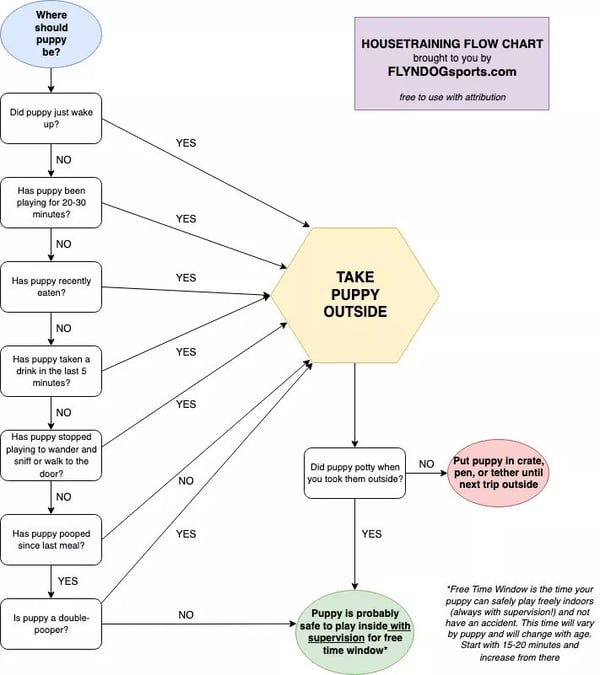
It's going to feel like you're always outside with your puppy — but doing so means faster house training and fewer indoor potty accidents! As the adage goes, "Short-term pain for long-term gain" is, in this instance, very true.
In a month or two, your pup could be a rockstar and have very few to no accidents indoors.
Your Puppy's Feeding Schedule
Eating a meal increases the chance that your puppy will need to go to the bathroom soon thereafter. The digestive process is "moving it along" inside your pup! Needing to defecate after eating happens because of the gastrocolic reflex.
When food reaches your puppy's stomach, the nervous system sends out a signal to their colon that more food is on the way — basically saying "Empty out because we need more room!" Take your puppy outside about ten to fifteen minutes after every meal.
Don't Free Feed Your Puppy
If your puppy has access to food all of the time, it's much harder to predict when they'll need to go to the bathroom. Free feeding also makes it difficult to track whether they are eating enough or too much, and can also make it more difficult for you to pick up on certain problems.
If your puppy isn't eating their meal within 15 minutes of putting it down, put it away until the next feeding time.
Learn more about why free-feeding isn't the best choice for puppies in our article "Think Twice About Letting Your Dog Free-Feed."
If you're noticing a consistent lack of appetite, check in with your veterinarian to make sure your puppy is healthy. You might consider changing your puppy's food or adjusting the number of treats or chews they are getting throughout the day.
Since treats should make up no more than ten percent of your puppy's daily food intake, you can set aside a portion of their regular kibble to use as training treats.
And if you're going to change the brand of food you feed them, do it slowly.
Keeping your puppy on a regular feeding schedule will help you monitor their calorie intake and help make their "number two's" easier to plan for.
o keep up with higher puppy metabolism, many puppy owners feed their puppy three meals a day. Expect at least the same number of defecations per day as meals.
Example Puppy Feeding Schedule |
|
| Breakfast | 7:00 am |
| Lunch | 12:00 pm |
| Dinner | 5:00 pm |
A feeding schedule like the above example provides for an early dinner that gives the puppy sufficient time to digest and have a pre-bedtime bowel movement.
You can easily write in your puppy's feeding schedule (and track to see if they have been given their meal by anyone else each day) by using the Puppy Potty Log below.
Keep a Puppy Potty Log
If you have multiple people in your home, posting a puppy potty log can help prevent accidents and keep everyone on the same page. Post the potty log somewhere close to the door leading outside, where it's easy to fill out.
Download this free Puppy Potty Log template we created for you.
The Potty Log is also a useful tool to figure out any patterns when there are accidents inside.
If you notice that your puppy always has an accident around 1:00 pm, then you know to adjust their schedule and add in a potty break around 12:45 pm.
If you're noticing a pattern on your potty log of frequent urination or bowel movements, or things like diarrhea, excessive amounts of urine, or lack of pees and poos, it's time to check with your veterinarian to rule out medical problems that can cause these issues.
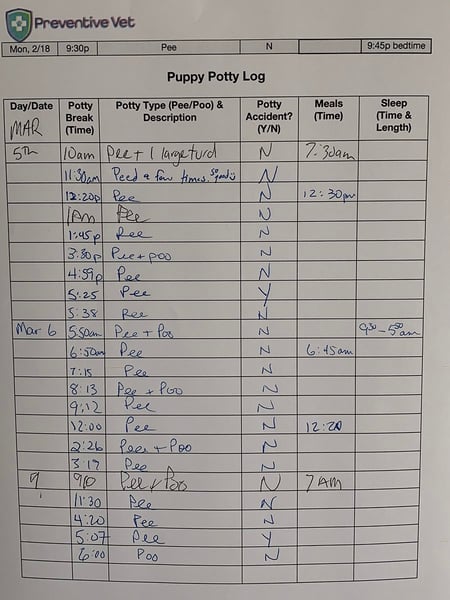 Here's an example of Finnegan's filled-out puppy potty log in the Preventive Vet Office. Having the log posted made it easy for all of our team members to mark off when we took him outside for a potty break, and for his owners to know if he still might need to go number two after a meal.
Here's an example of Finnegan's filled-out puppy potty log in the Preventive Vet Office. Having the log posted made it easy for all of our team members to mark off when we took him outside for a potty break, and for his owners to know if he still might need to go number two after a meal.
How Long Can Your Puppy "Hold It"?
We can generally expect puppies to be able to physically "hold it" during the daytime based on the following equation:
# of months old + 1 = # of hours
For an 8-week-old puppy (2 months), this would be: 2 + 1 = 3 hours.
For a 16-week-old puppy (4 months), it would be: 4 + 1 = 5 hours.
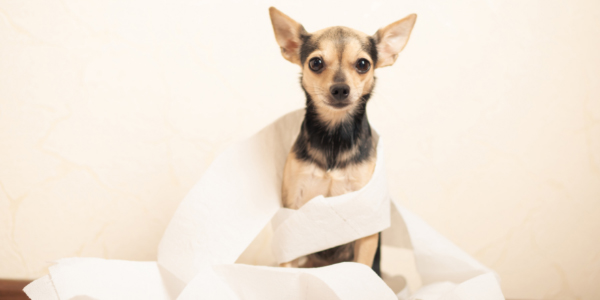 Potty Training Your Puppy at Night
Potty Training Your Puppy at Night
At nighttime, you don't need to take your puppy outside as frequently as during the day since your puppy is (hopefully) sleeping. For very young puppies or a puppy that's still relatively new to the home, plan for one to two nighttime potty breaks.
I suggest setting an alarm for these nighttime bathroom breaks for the first week you have your puppy. This way, you're not waiting until your puppy starts whining or barking to go outside.
The break should be low-energy and short, just time enough for them to go potty and then back into the crate to fall asleep again.
As they settle into a nighttime routine and begin sleeping longer through the night, you can start to extend the amount of time between bathroom breaks.
I don't expect puppies under four months old to be able to make it through an entire night without needing a bathroom break, but every puppy is unique — some puppies hit this milestone sooner than sixteen weeks of age, and others might take a bit longer.
How Crate Training Your Puppy Helps with Potty Training
Crate training at night can be extremely helpful in preventing potty accidents, as well as helping your puppy sleep through the night.
While using a puppy zone during the day, having your puppy sleep in a smaller, more den-like space will help their bodies adjust to "holding it" longer at nighttime. For how-to's and tips, read our article "Crate Training Your Puppy at Night."
Signs Your Puppy Needs to Go Potty
It can be hard to tell when your puppy is "saying" they need to go outside! Oftentimes, the subtle changes in body language happen fast, and before you know it, your puppy has an accident inside.
During house training, puppies need almost constant supervision. Keep a close eye on your pup whenever they are enjoying some freedom outside of their crate or puppy zone, so you can watch for signs they need to go potty.
Some signs your puppy may need to go to the bathroom include:
- Suddenly stopping an activity, such as chewing or playing
- Pacing back and forth or in circles
- Excessive sniffing
- Searching out a more hidden area, such as a far corner, behind the sofa, or going into a different room
- Whining
- Sniffing or licking their groin or rear-end area
- Jumping or pawing at the door
- Trying to get your attention with barking or pawing at you
This video of Finnegan shows examples of body language that he needs to go to the bathroom (although he had just been out for a potty break not long before). Notice the vocalization, circling, sniffing, and pacing:
PRO TIP: Set up a camera to keep an eye on your puppy in their puppy zone for when you can't be supervising them.
This not only helps catch any signs they need to go potty (day or night), but you can also go back in the recording to see when they had their accident so you can plan for the future.
Cameras like the Furbo connect to your smartphone with an app that notifies you if there is noise or movement, and even let you toss a treat remotely if your pup is behaving.
Train Your Puppy to Use Potty Bells or Buzzers
Many puppy owners find that training their puppy to ring a bell or push a buzzer at the door helps them know if their puppy needs to go to the bathroom.
Once a puppy has learned that ringing the bell means the door opens, it's easier for them to let us know in an obvious way that they want to go potty.
However, using potty bells only works if you've been consistent in rewarding their outdoor house training! Otherwise, they don't know they're supposed to go potty outside, so why ring the bell to open the door?
You can introduce potty bells or buzzers in a couple of ways to your puppy.
Some owners teach their puppy first to target the bells before pairing it with the door opening. Others hang up the bells or put the buzzer by the door and add ringing them into the potty break routine.
Any time you're on your way outside, encourage your puppy to hit the bell or button and reward with the door immediately opening and lots of praise!
PRO TIP: Be careful not to do the work for your puppy! Don't lift their paw for them to hit the bells or touch the bells to their nose. Instead, encourage them to interact with the bells on their own so they learn that they make the bells ring, which then makes the door open.
Watch Preventive Vet puppy Finnegan show off his potty doorbell skills in this video:
Since puppies are incredibly smart, you might see your puppy take advantage of bells at the door. Once they learn that ringing them means the door opens, you might hear them ring every time your puppy wants to play outside.
Some puppies also just love playing with the bells themselves (which can be dangerous if they chew on them or ingest the bells — no one wants a gastrointestinal obstruction)!
For many of my clients, they will train their puppies to use potty bells or buzzers when they first start house training, but once their puppy is reliably house trained, they will remove them.
Finnegan was catching on that using the bell was getting him access to go outside any time he wanted, so if he didn't go potty right away, his owners brought him back inside right away. He's learned and doesn't abuse his skills too much anymore.
PRO TIP: If you're using a buzzer like the one shown in the video above, make sure the button is easily visible for your puppy to see and then target.
We placed one of these blue felt stickers on Finnegan's buzzer (dogs can see the colors blue and yellow better than others) so he knew where to push with his nose.
Should You Use Puppy Potty Pads?
There are pros and cons when using puppy potty pads. They can be useful for a variety of homes, such as high-rise apartments or a home without a yard or patio.
I recommend using them in a puppy pen to provide an easy-to-clean area for indoor accidents and to protect your floor or carpets. However, they may make transitioning to outdoor-only house training more difficult for some puppies.
To learn more about the pros and cons of using pee pads with your puppy, check out "Pee Pad Training: Is It a Good Idea?"
If possible, I recommend using grass or grass-like potty pads rather than paper potty pads. These work well on an outdoor patio, as the smell of ammonia might get too overwhelming when using them indoors.
There are even monthly subscriptions you can sign up for that will deliver fresh patches of grass to your door!
Using these types of potty areas can make transitioning to going to the bathroom outside only on the grass easier for your puppy — they'll already be familiar with the feel of grass under their paws and have an association between that surface and where they go potty.
And make sure you have an easy place to dispose of your puppy's waste if you're using an indoor potty spot or porch potty area. Having a waste station means fewer trips to the dumpster or outside garbage and less stink in your home!
What to Do When Your Puppy Has a Potty Accident
If your puppy is going to the bathroom inside and you see them in the act, interrupt them if you can. Clap your hands or say their name in an excited voice to try and stop them from finishing where they are.
Scoop them up and take them outside to their potty spot immediately. If they finish going potty outside, praise and reward them.
If they don't go in their designated potty spot, take them inside for a few minutes and put them in their crate or puppy zone while you clean up the pee or poo accident. Then take them outside again to see if they go potty.
Mark the time of the accident on your potty log and then adjust your puppy's breaks to prevent future accidents.
If your puppy had an accident you didn't see happen, calmly take them outside to see if they still need to go, then thoroughly clean the accident. Improperly cleaning up their accidents can contribute to more accidents!
Mark down the approximate time of their accident (or check your webcam's footage for the timestamp) and consider whether you need to adjust your potty break schedule to prevent future accidents.
What NOT to Do When Your Puppy Has a Potty Accident
- Don't yell, hit, or punish your puppy. It's frustrating to step in a puddle or pile of poo. But punishing your puppy for potty accidents actually sets back your house training process and damages the trust your puppy has in you.
Plus, if you're punishing long after the actual act of going to the bathroom, your puppy isn't learning not to go potty inside, they're just learning that your presence predicts something scary.
Punishment for house training accidents often results in a puppy that will seek out a secluded area to go potty inside — somewhere away from you. - Don't rub your puppy's nose in their accidents. There is no reason to push your puppy's face into their potty accident. It does nothing to teach them that going potty inside is "bad," and it creates a negative association with you.
Any guilty look that you may see is not a sign your puppy feels bad about having an accident. That look is actually an appeasement gesture — your puppy sees that you're angry and is trying to tell you they are no threat. - Don't forget to thoroughly clean the accident spot. The scent of urine or feces can encourage your puppy to go in the same spot in the future — and their noses are incredibly talented at sniffing out previous potty spots!
We might think that we've gotten the stain out, but any scent left behind is setting your puppy up for another accident. Use an odor-neutralizing cleaner made specifically for dog accidents, such as Urine Off or Anti-Icky Poo.
Read more cleaning tips in our article "Cleaning Up Puppy Pee and Poo Accidents."
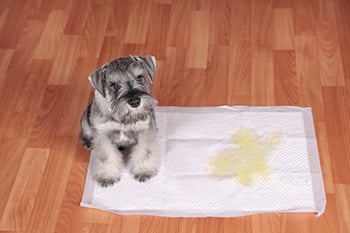
What Medical Issues Could Inhibit Puppy Potty Training
Potty training problems could actually have nothing to do with your ability to potty train your puppy.
Unfortunately, some puppies are born with medical problems or acquire them at an early age, and these issues can undermine even the most seasoned trainer’s potty-training techniques!
When in doubt, ask for help. Your vet can rule out medical problems.
Here are a few of the medical problems that could complicate a pup’s potty training progress:
If your puppy is peeing in the house:
- Urinary tract infection
- Bladder inflammation (“cystitis”)
- Bladder or kidney stones
- Patent urachus
- Ectopic ureter
- Liver disease (e.g., shunt)
If your puppy is pooping in the house:
- Intestinal parasites like worms, Coccidia, Giardia, or others
- Inflamed stomach, pancreas, or intestines from food that may be too “rich” for them
- Being fed too many meals or meals that are too large
- A deficiency in pancreatic enzymes
Regression in Puppy Potty Training
Even if you're doing everything you can think of to set your puppy up for success, don't get discouraged if your puppy has a potty accident inside. It's not abnormal for regression in potty training as your puppy grows, especially if their routine or environment changes.
Any time your puppy regresses, go back a few steps in their potty training — take more potty breaks, increase supervision, and reduce your puppy's access to certain areas of the home and their freedom to roam.
It takes time for your puppy's body to mature enough to hold it throughout the day and night, and consistency in their house training routine to help them learn where they are supposed to go.
A positive, rewards-based dog trainer can be worth their weight in gold! Remember, you’re not alone … even if it feels that way at 3:00 a.m. when you’re standing in the rain in your PJs, watching and waiting for your pup to finish their business.
The more consistent you are in your puppy's routine and the more patient you are during the process, will pay off big time in the long run.
Raising a puppy is a lot of work, and many puppy owners experience "puppy blues" and feel exhausted or overwhelmed with the responsibility and expectations.
Take it one step at a time and reach out to us or your dog trainer for support. We're here to help!
Let us know what questions you have about your puppy's potty training in the comments below!
Stop potty accidents and get help with house training in our Puppy Essentials: Potty Training Workshop
Includes unlimited access to self-paced training sessions, videos, downloadable resources, and more — all for only $9!


